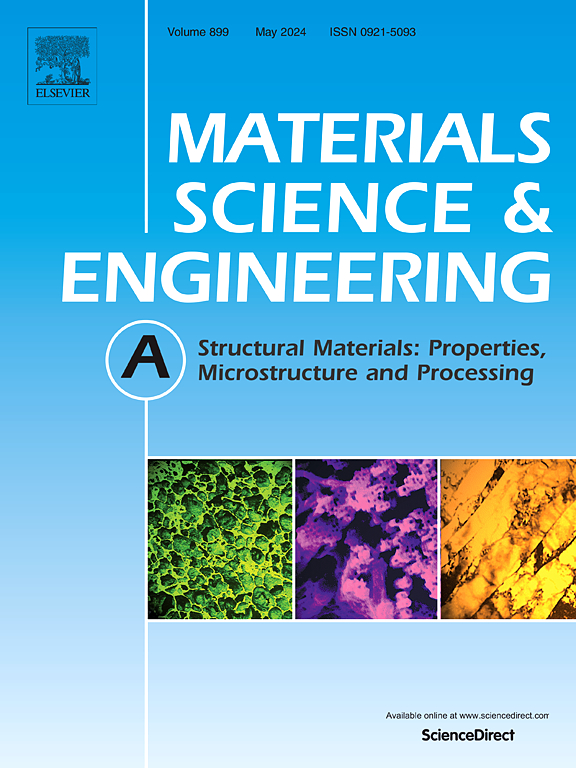Achieving balanced strength and toughness in 2.5Ni-Cr-Mo steel via submerged arc additive manufacturing by regulating intrinsic heat treatment
IF 7
2区 材料科学
Q1 MATERIALS SCIENCE, MULTIDISCIPLINARY
引用次数: 0
Abstract
Submerged arc additive manufacturing (SAAM) is attractive for the production of large-size, medium-complex parts. The approach enables the manipulation of ‘full-layer-penetrated’ intrinsic heat treatment (IHT) and thus the resulting metal's microstructure, by controlling the processing parameters. We recently found that this IHT can trigger repeated recrystallizations involved with allotropic transformation in the high-strength low-alloy steel. Here, we report a 2.5Ni-Cr-Mo steel, inherently sensitive to grain boundary-segregated impurities and blocky martensite/austenite (M/A) phase, of which microstructure and properties are tailor-designed via SAAM. The α-Fe phase matrix of this steel is refined in situ by multiple recrystallization whilst impurities are desegregated as the prior-γ grain boundaries disappeared. M/A phase is then finer and is deliberately dispersed via in situ element partitioning, followed by an long-duration tempering. Control of multiple recrystallization, impurity desegregation and dispersion of M/A phase leads to a near homogeneous microstructure, enabling the substantial improvement on impact toughness (∼9 J–∼42 J at −60 °C, for half-sized specimen). Our material has a tensile strength of 820 MPa, yield ratio of 0.65–0.72, and ductile-brittle transition temperature of −80 °C, exhibiting superior mechanical properties to those of common engineering steels. SAAM approach and the principles of in situ microstructure control provides new idea and avenues for new additive manufacturing and the development of heavyweight steel parts for various industrial applications.
通过调节本质热处理,采用埋弧增材制造技术实现2.5Ni-Cr-Mo钢强度和韧性的平衡
埋弧增材制造(SAAM)对于生产大尺寸、中等复杂的零件具有很大的吸引力。通过控制加工参数,该方法可以实现“全层渗透”本质热处理(IHT),从而获得金属的微观结构。我们最近发现,在高强度低合金钢中,IHT可以触发与同素异向转变有关的重复再结晶。本文报道了一种对晶界分离杂质和块状马氏体/奥氏体(M/ a)相天生敏感的2.5Ni-Cr-Mo钢,其显微组织和性能通过SAAM进行了定制。该钢的α-Fe相基体通过多次原位再结晶得到细化,同时随着-γ晶界的消失,杂质被析出。然后,M/A相变得更细,并通过原位元素分配故意分散,随后进行长时间回火。控制M/A相的多次再结晶、杂质解聚和弥散导致接近均匀的微观组织,从而显著提高了冲击韧性(在- 60°C时,半尺寸试样的冲击韧性为~ 9 J ~ ~ 42 J)。材料的抗拉强度为820 MPa,屈服比为0.65-0.72,韧脆转变温度为- 80℃,与普通工程钢相比,具有优越的机械性能。SAAM方法和原位组织控制原理为新型增材制造和各种工业应用的重型钢零件的开发提供了新的思路和途径。
本文章由计算机程序翻译,如有差异,请以英文原文为准。
求助全文
约1分钟内获得全文
求助全文
来源期刊

Materials Science and Engineering: A
工程技术-材料科学:综合
CiteScore
11.50
自引率
15.60%
发文量
1811
审稿时长
31 days
期刊介绍:
Materials Science and Engineering A provides an international medium for the publication of theoretical and experimental studies related to the load-bearing capacity of materials as influenced by their basic properties, processing history, microstructure and operating environment. Appropriate submissions to Materials Science and Engineering A should include scientific and/or engineering factors which affect the microstructure - strength relationships of materials and report the changes to mechanical behavior.
 求助内容:
求助内容: 应助结果提醒方式:
应助结果提醒方式:


